4 Minutes
Unveiling the Secrets of Sagittarius A*: The Milky Way's Central Black Hole
At the heart of our Milky Way galaxy lies Sagittarius A (Sgr A), a supermassive black hole with a mass equivalent to about four million Suns. Recent research using advanced artificial intelligence and imaging data from the groundbreaking Event Horizon Telescope (EHT) has revealed that Sgr A* is spinning at nearly its maximum theoretical speed, pushing the limits set by the laws of physics.
The Event Horizon Telescope: Pioneering Black Hole Imaging
The Event Horizon Telescope is an international collaboration that synchronizes radio telescopes around the globe, effectively creating an Earth-sized observatory. Its most notable achievement has been capturing the first-ever direct images of black hole shadows—first of M87 in the distant Virgo galaxy and then of Sgr A, offering humanity unprecedented glimpses of these enigmatic cosmic giants.
While these images marked a historic milestone, interpreting them remains a significant scientific challenge. The data is limited in detail and influenced by the complex physics near a black hole’s event horizon. To overcome these challenges, astrophysicists turn to sophisticated computer simulations and artificial intelligence, seeking to decode the observational data into meaningful physical properties.

AI-Driven Insights: Rethinking Black Hole Behavior
A team led by astronomer Michael Janssen—affiliated with Radboud University in the Netherlands and the Max Planck Institute for Radio Astronomy in Germany—developed an innovative approach. Leveraging high-throughput computing, they simulated millions of theoretical black holes, each with varying parameters such as spin speed, orientation, and surrounding material. These simulations were then used to train neural networks capable of extracting subtle features and patterns from the real EHT data.
Through this AI-enhanced analysis, the team found compelling evidence that Sgr A is spinning at velocities close to the extremal, or maximum, rate allowed by Einstein’s theory of general relativity. Intriguingly, the spin axis of Sgr A is oriented toward Earth, and the observed bright ring encircling the black hole is the result of hot electrons emitting powerful radiation in its warped space-time environment.
Perhaps the most surprising discovery concerns the behavior of the magnetic fields in the matter swirling around Sgr A*. Contrary to leading theoretical predictions, the magnetic properties observed do not align perfectly with existing models—an indication that current black hole physics may require further refinement.
Comparisons With Distant Black Holes: The M87* Case
The study also extended to M87, the supermassive black hole at the core of the Virgo A galaxy, 55 million light-years from Earth. Although M87 is also spinning rapidly, it does so more slowly than Sgr A. Remarkably, M87 appears to be rotating in the opposite direction relative to the disk of infalling material, a feature possibly caused by an ancient merger event with another gigantic black hole.

Expert Perspectives and Future Prospects
“Defying current theoretical expectations is both exciting and challenging,” said Dr. Michael Janssen. He emphasized that while artificial intelligence and machine learning represent significant first steps, further refinement of models and broader data collection are crucial for deepening our understanding.
The upcoming Africa Millimetre Telescope, currently under construction, will soon join the EHT network, promising even more precise observations of supermassive black holes. Enhanced data will allow scientists to rigorously test the fundamental principles of general relativity and unravel the true nature of gravity in the most extreme environments known.
Conclusion
The latest findings from the Event Horizon Telescope collaboration, amplified by cutting-edge AI techniques, mark a new era in black hole astrophysics. The near-maximal spin of Sagittarius A* and unexpected magnetic field anomalies highlight both our progress and the many mysteries that remain. As new observatories join the quest and computational methods evolve, our picture of the universe’s most powerful objects will continue to come into sharper—and perhaps even more surprising—focus.
Source: sciencealert



Comments